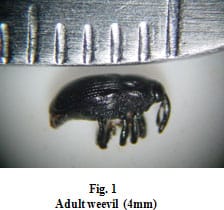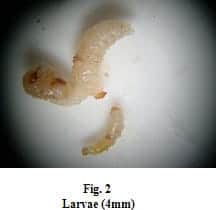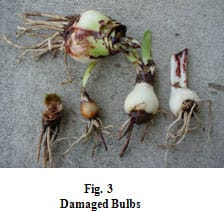Source(s): Jacob G Price
Introduction
The Amaryllis Weevil, (Coleoptera: Curculionidae), is an exotic and yet un-described weevil that was first found in Amaryllis plants in Tampa, Florida in 1989. The weevil was first documented in Amaryllis in Lowndes County, Georgia in 2006. The weevil has also been reported to have damaged Crinum Lilies and Spider Lilies in Lowndes County.
Life Cycle
The adults, (fig. 1), may live up to two years, are shiny black, and measure 4mm in length and 2mm in width. Adults feed on foliage, but the most damage is from the larvae. Amaryllis Weevils lay eggs on the leaves which hatch and tunnel their way towards the bulb. The Amaryllis Weevil larvae, (fig.2), destroy bulbs by their feeding activity which usually begins at the base of the leaves and extends into the bulb (fig.3). With severe infestations the larvae will hollow out and destroy the bulbs. Larvae are believed to pupate in the surrounding soil and emerge as adults.
Controls
Adult weevils are believed to be weak flyers and are most likely spread from the transport of bulbs. Use caution when introducing new plants to your garden. In situations where infestations are severe, products containing imidacloprid (Bayer Advanced Tree & Shrub or Merit), should help control infestations. Removing all susceptible Amaryllis, Crinum Lilies, and Spider Lilies, for two years will also benefit.
Resource(s):
Insect Pests of Ornamental Plants
Reviewer(s):
- Ellen Bauske, UGA Center for Urban Agriculture, The University of Georgia College of Agricultural and Environmental Sciences.
- Randy Drinkard, UGA Center for Urban Agriculture, The University of Georgia College of Agricultural and Environmental Sciences.
Center Publication Number: 274
- Growing Asparagus: A Luxury Vegetable - September 24, 2013
- Frizzle Top in Sago Palms - September 24, 2013
- Growing Onions in the Home Garden - September 24, 2013


